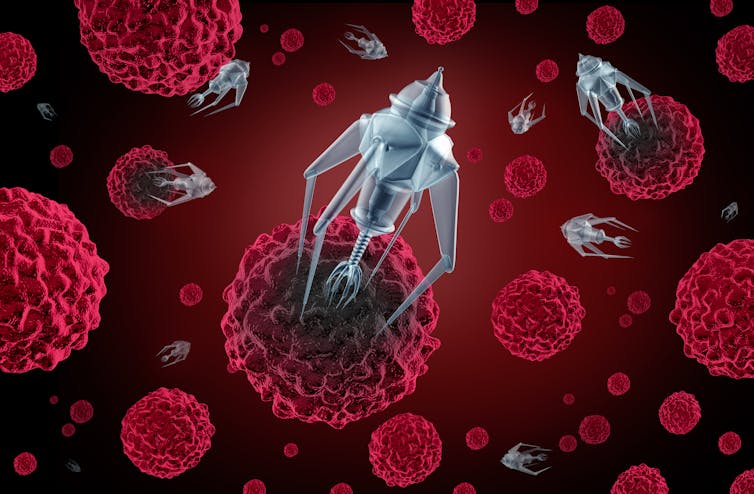Nanotechnology
It is the beauty of nanotechnology that it makes things smaller and has a bigger impact on our lives.
Nanotechnology is a rapidly growing field that involves the manipulation of materials at the nanoscale, which is roughly between 1 to 100 nanometers in size. A nanometer is one-billionth of a meter, and nanotechnology is all about reliably manufacturing technology at such tiny scales. Nanomaterials are materials with one or more dimensions in the nanoscale, and they possess unique properties that make them desirable for various applications
.In this blog post, we will discuss the latest research on nanomaterials and their potential applications in various industries.

Nanomaterials and their properties:
Nanomaterials can be classified into different types, including nanoparticles, nanotubes, nanofibers, and nanosheets. These materials have unique physical, chemical, and mechanical properties that differ from those of their bulk counterparts. One of the most notable properties of nanomaterials is their surface area-to-volume ratio, which makes them more reactive and allows for a higher degree of interaction with their surroundings.
Another unique property of nanomaterials is their quantum confinement effect, which arises from the confinement of electrons in a small space. This effect results in changes in the electronic and optical properties of the material, such as increased luminescence and absorption. Additionally, nanomaterials can exhibit size-dependent properties, such as increased strength and ductility, when compared to their bulk counterparts.
Applications of Nanotechnology in various industries:
Nanotechnology has the potential to revolutionize various industries by enabling the development of new materials and devices with improved performance and functionality. Here are some of the potential applications of nanotechnology in different industries.
1. Healthcare industry:
Nanomedicine is a rapidly growing field that involves the use of nanomaterials for diagnostic and therapeutic purposes. Nanoparticles can be designed to target specific cells or tissues, allowing for more precise drug delivery and lower doses of drugs. Additionally, nanomaterials can be used for imaging, such as in magnetic resonance imaging (MRI), by improving contrast and reducing the required dosage of contrast agents.
Nanomedicine offers endless possibilities, from monitoring inflammation and post-surgical recovery to more unusual instances in which electronic devices interfere with our bodies’ signals for controlling organ function.
2. Energy industry:
Nanotechnology can play a crucial role in developing more efficient and sustainable energy sources. For instance, nanomaterials can be used to improve the performance of solar cells by increasing their absorption of light and reducing the recombination of electron-hole pairs. Additionally, nanomaterials can be used in fuel cells to enhance their catalytic activity and reduce their cost.
3. Electronic industry:
Nanosensors are devices that can detect and respond to small changes in the environment, such as changes in temperature or pressure. Nanomaterials can be used in nanosensors to improve their sensitivity and response time. Nanoelectronics is another area where nanotechnology can make a significant impact by enabling the development of smaller and more efficient electronic devices.
4. Environmental industry:
Nanotechnology can also be used in environmental applications, such as in water treatment and air filtration. Nanomaterials can be used to remove contaminants from water, such as heavy metals and organic compounds, by adsorption or photocatalysis. Additionally, nanomaterials can be used in air filters to remove harmful particles and gases.
The future can show us nanoparticles that can harvest energy from their environment with high conversion efficiency. For example, energy can be harvested from movement, light, variations in temperature, glucose, and several other sources
5. The creation of graphene:
Another promising application of nanoscience is in the utilization of graphene, and other super-materials using passive nanostructures. Graphene is a nanomaterial that comprises a solitary sheet of carbon of the thickness of one atom. The material is exceptionally hard and has promising electrical conduction properties. Not just that, but it’s flexible as well. Some of the astounding properties of graphene are:
- Compared to steel, it is 200 times stronger and six times lighter.
- It is a superconductor of electricity.
- It can stretch up to 20% of its length.
- It can endlessly bend without breaking.

Therefore, graphene-based technologies have tremendous potential in the future, such as flexible solar cells for energy generation and flexible screens for smartphones. Due to its outstanding aqueous processability and other functional surface properties, graphene can also be used to fabricate biomedical sensors for biosensing, bioimaging, and therapeutic applications.
Advancements in Nanotechnology:
Recent advancements in nanotechnology have opened up new possibilities for the development of novel materials and devices with improved performance and functionality. One recent breakthrough is the development of two-dimensional materials, such as graphene and molybdenum disulfide, which have unique electronic and mechanical properties that make them attractive for various applications, including nanoelectronics and energy storage.
Another exciting development is the use of DNA as a template for the synthesis of this approach allows for the precise control of the size, shape, and composition of the resulting nanomaterials, which can be useful for applications such as drug delivery and catalysis.

However, with these exciting developments come ethical concerns and safety considerations. Nanoparticles have the potential to enter the human body and interact with cells and tissues, which raises concerns about their toxicity and long-term effects. Researchers need to conduct through studies on the safety of nanomaterials before they are used in various applications.
In conclusion, nanotechnology is a rapidly growing field that has the potential to revolutionize various industries by enabling the development of new materials and devices with improved performance and functionality. Nanomaterials possess unique properties that make them desirable for various applications, such as in healthcare, energy, electronics, and environmental.


Good insights on nanotech! I’ve myself worked on project in nanotechnology!
Kudos to you!